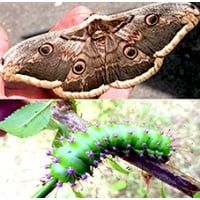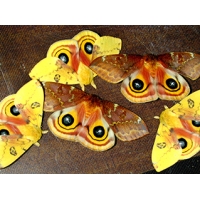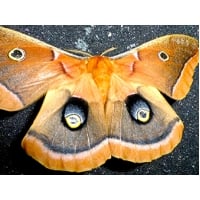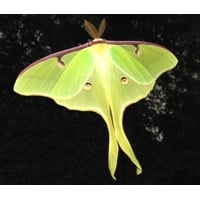WINTER PUPAE for breeding in the following season
Giant Peacock Moth Saturnia pyri
Magnificent - Europe’s largest moth. Flies in May, pairs easily and lays prodigiously. Exotic looking larvae.
Rear the larvae in warm, dry conditions. They are very easy to rear in the first instars and extra care is needed to bring them through the final instars. They repay proper care, growing fast and changing colour.
The large larva is as handsome as the tropical Saturniidae and has much in common with Moon Moth larvae, but with sapphire blue tubercles. They do well on Blackthorn and Plum and will often feed on other fruit trees and Hawthorn, Willows, Alder and Birch.
Ligurian Emperor Moth Saturnia pavoniella
Slightly larger than our Emperor. A joy to breed: with amazingly varied larvae, quite distinct from Emperor larvae.
Although the moth is similar to our Emperor Moth pavonia, pavoniella male has a paler band on the hindwing inner margin. There are other differences in appearance and the intensity of pattern, particularly in the male.
Large larvae are quite distinct from those of pavonia, and very diverse in their colouring (see pictures). Foodplants are the same as for pavonia and include Apple, Plum, Blackthorn, Bramble, Hawthorn, Heather, Willow, Birch, and many others. Pavoniella females pair several times (pavonia only once). The two species hybridise easily but the progeny of hybrids of pavonia with pavoniella are infertile, which indicates that pavoniella is a true species. Pavoniella is found in central Europe, extending south to Greece and for some distance into Turkey and well into Asia Minor.
Pairing is very easy in sunshine. Rearing the larvae is most rewarding and interesting. Do give this species a try!
Bullseye Moth Automeris io North America
This small silkmoth has a number of interesting characteristics. The male and female are distinctly different colours – both have the enormous eye markings on the hindwings which are exposed when the moth is disturbed. The larvae are covered by branched spines – don’t touch them – they sting like a nettle. They are gregarious until the larvae are quite large, changing colour at each skin change. Very interesting and easy to rear.
For pairing, keep the moths in a cage the size of the Pyjama Mini Cage. Fertile eggs develop a black dot which is the micropyle, through which the embryo breathes. A useful indicator of fertility, not present in most other species.
The larvae are polyphagous, ie they will accept a wide variety of foodplants, which include such trees as Oak, Lime, Willow, Hazel, Bramble, Apple, Hawthorn and more.
American Oak Silkmoth Antheraea polyphemus
The hindwings of both sexes have huge target eyespots. Pairing sometimes easy, other times changes of setup are needed. The female lays a large number of eggs.
The larvae are easy to rear on Oak or Osier Willow. Along the sides of larger larvae there are silver spangles, like drops of mercury. Lovely larvae to rear.
They are also reported to feed on Hawthorn,Oak, Birch, Willow, Sallow, Maple, Apple, Cherry, Alder, Elm. Also try Walnut, Pseudacacia, Sumac Rhus typhina.
American Moon Moth Actias luna North America
A very attractive Moon Moth that emerges from May and breeds exceptionally easily. The larvae feed well on Walnut, Birch, Osier Willow, Liquidambar, Plane, Maples, Aspen, Plum, Sallow, Several kinds of Oak and maybe other foodplants.
A second brood is produced in late summer. Winter is passed in the cocoon stage. Store them cold from November until April. May is the normal emergence time for the first brood.





